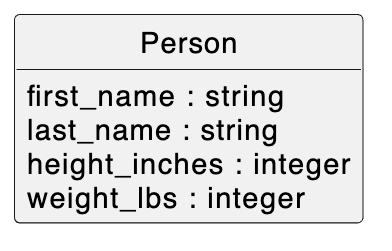Create Model Class and Migrate Database
Task
- Generate a new model class,
Person(as per the class diagram below), and initialize the database for savingPersonobjects.

Steps
Pre-Task Steps
Inspect model files and folders:
app/models/- folder where model classes go (currently empty).app/models/application_record.rb- a base class inherited by all model classes.
Inspect database tables:
psql --command="\dt" app_development
- Lists only two default tables,
ar_internal_metadataandschema_migrations. - ⚠️ Press Q key to quit if command locks terminal.
Task Steps
Generate model class Person and database migration script:
rails generate model Person first_name:string last_name:string height_inches:integer weight_lbs:integer
Run migration to configure database:
rails db:migrate:reset
Post-Task Steps
Inspect the database tables:
psql --command="\dt" app_development
- Now includes
peopletable. - Table name is plural
snake_caseform of class name (Personclass →peopletable). - ⚠️ Press Q key to quit if command locks terminal.
Inspect schema of people table:
psql --command="\d people" app_development
- Includes attribute columns,
first_nameandlast_name. - Includes
id, a unique ID number for each row. - Includes
created_atandupdated_at, automatically generated timestamps. - ⚠️ Press Q key to quit if command locks terminal.
Inspect rows of people table:
psql --command="SELECT * FROM people" app_development
- Currently has 0 rows.
- ⚠️ Press Q key to quit if command locks terminal.
Inspect generated migration:
db/migrate/20240203174351_create_people.rb- migration script for setting up database.- Contains call to
create_tablefor adding new table to database. - Numbers in file name are timestamp indicating when file was generated.
- Contains call to
Inspect generated model class:
app/models/person.rb- code file to open in VS Code.- Class
Persondefinition empty because Rails automatically generates attributes based ondb/schema.rb. - Annotate-generated comments list attributes.
- Class